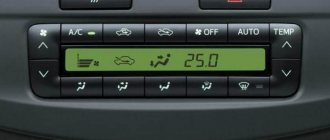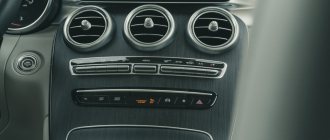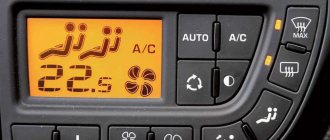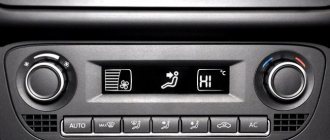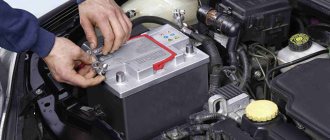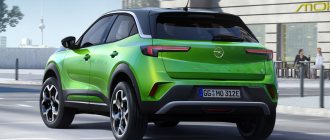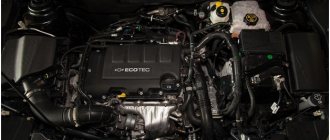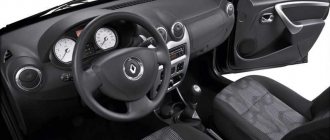Differences between climate control and air conditioning
Let's look at the main differences between the two systems:
Control. An automated system is contrasted with manual adjustment of the operating mode. The driver is distracted from studying the road, which can lead to an emergency situation.
Climate control panel
- Comfort level. The task of the ECU is to regulate the zoning of air cooling, taking into account the justification of using air ducts. In technical terms, the opponent clearly loses.
- System complexity. The multi-level system is devoid of the disadvantages inherent in individual components. Climate control combines components into a single organism; increasing their number improves the quality of the ECU.
- Price policy. The automated system is not cheap, but it pays off handsomely in terms of comfort and fuel economy. Drivers who make a choice based on price will give preference to cheaper components.
It is better to buy a used car with air conditioning - the cost savings are obvious. In case of sale the situation is opposite.
Climate control is characterized by an increased level of comfort for the sake of cheapness and accessibility. Air conditioning is more attractive to middle-income consumers.
Climate system operating options
Many car owners who have moved from old Zhiguli cars to a decent car do not know how to use climate control. Despite the design complexity of the system, it is as user-friendly as possible. All manipulations are carried out from a very simple and intuitive control panel. You don't even need to open the instruction manual to understand the controls.
There are manual and automatic operating modes of the climate control system. In the first case, you need to thoroughly know all the intricacies of climate control. If, out of ignorance, you incorrectly configure the system from the climate control panel, there is a risk of reducing the service life of the entire complex.
In manual mode, by turning knobs or pressing buttons, you can adjust the fan speed, the level of cooling or heating of the air. The conditions for air entering the cabin are adjusted. Manual mode is intended for those cases when you need to heat or cool the air very quickly.
Automatic mode is used for long trips. To activate this mode, you need to press the corresponding button and set a comfortable temperature. All actions related to setting the dampers, air flows and their strength will be taken over by the control unit.
Car enthusiasts often don't use automatic modes (and not because they don't know how to use climate control). If you choose this scheme, the fan is very annoying - it runs at high speeds, creating noise. But this is only the initial stage of operation - after a few minutes the fan will switch to normal mode and stop making noise. The system will only maintain the set temperature.
What is climate control in a car?
Using a series of sensors, the climate control system constantly measures the air temperature in the cabin. From here it can be determined how cold or hot the air pumped into the cabin must be to maintain the desired temperature set by the driver.
Other parameters that the system can adjust are fan speed and recirculation settings (whether fresh air is brought in from outside or recirculated air into the cabin).
Many cars now have two- or three-zone (sometimes called multi-zone) climate control, in which the car can maintain two or three separate temperature zones. For example, the driver's climate control zone could be set to 23 degrees, the passenger's climate control zone to 18 degrees, and the rear of the car to 25 degrees.
Dual-zone climate control is the process of dividing the interior of a car into sections or zones, and each section can have a separate air conditioning setting.
Climate control is part of the heating, ventilation and air conditioning system, which also controls the defrost of the windshields, heated steering wheel and heated seats. Most automotive climate control systems can be described as using sensors and an ECU to add additional functionality to the vehicle's basic air conditioning system. Sensors measure the temperature inside and outside the car, so the system can automatically adjust to maintain a constant temperature inside the car regardless of the temperature outside.
Sensors also check the air for unwanted particles to clean the air, remove odors and regulate humidity before it enters the passenger compartment. Several types of systems are described below, each of which takes advantage of the benefits listed above. An advanced climate control system may have more than one compressor in the engine compartment.
QC control panel
Dual zone climate control
There are separate controls for the driver and front passenger, allowing them to have different temperatures and fan speeds if desired. This will eventually result in the entire left and right sides of the car having different air conditioning. Controls for both zones are located on the dashboard, where you typically find air conditioning controls.
Three-zone climate control
There are separate controls for the driver, front passenger and rear seat. This allows passengers in the car's rear seats to have their own settings independent of the dual settings in the front. Rear-seat climate control controls are typically located at the rear of the center console. For vehicles such as minivans, large crossovers, or SUVs with a third row of seats, third seat settings are typically used for the third row.
Four-zone climate control
There are separate controls for the driver and front passenger, and the rear seat is split in two with separate controls for each half, allowing the four passengers to enjoy their own climate control settings. If there are five passengers in the car, the person sitting in the middle of the rear seat will enjoy a combination of left and right rear positions.
Due to the different zones, the vents are located in several places around the vehicle's interior. In addition to the normal location of the air vents on the dashboard, these additional air vents may be located in the rear of the center console (above the rear seat controls), in the b-pillars and on the roof of the vehicle.
Four-zone system
What does dual-zone climate control mean?
The first attempts to control the microclimate inside a car consisted of creating a heating system. A special radiator and fan were placed under the front panel - this is how hot air from the engine entered the cabin.
Over time, the heating system was improved - now heat was supplied to the rear seats. In addition, adjustment of air temperature and airflow intensity has been added.
Gradually, air conditioners, which had been around for a long time, were modified and reduced in size to such an extent that it became possible to install them in a car - so a cooling system was added to the heating system.
Thanks to the efforts of engineers, a new step was taken towards the creation of climate control - an automatic heater control system appeared in cars.
A special temperature sensor was installed on the ceiling, based on the signals from which the controller changed the operating mode of the heating fan.
THIS IS INTERESTING: How to get rid of condensation on plastic pipes?
As a result, a climate control system was developed, the operating principle of which was significantly different from its predecessors - the key to ensuring comfort in the cabin was the air conditioner, which mixed hot and cold air, and then sent the resulting mixture to the cabin.
What is dual-zone climate control
Dual-zone climate control maintains different temperature conditions and airflow intensity for the driver and front passenger using two sets of controls for one system. Thus, it became possible to adjust the microclimate separately for the passenger and separately for the driver. The two-zone option remains the most common, since three-zone and four-zone systems significantly increase the cost of the car.
Components of climate control
Climate control consists of two key components - the control system and the climate control system. The control system is an electronic control unit that controls the operation of sensors and so-called actuator components of the air conditioning system.
Components include:
- Dampers;
- Evaporator-heater unit;
- Capacitor;
- Refrigerant circuit;
- Temperature exchanger;
- Fan;
- A system of tubes under the body and trim of the car.
How dual-zone climate control works
The control system sensors record the temperature outside and inside the car. The incoming air flow is divided into two flows - one goes through the condenser evaporator, the second through the stove radiator. Then these two masses are mixed to the desired temperature and supplied to different areas of the cabin.
As soon as the external and internal temperatures change, the sensors record this and make adjustments to the operation of the system.
Thus, climate control performs several functions at once:
- Regulates and maintains the set temperature - if the actual temperature is lower than the set one, the control unit gives a command to turn on the heating system. On the contrary, if the actual temperature is higher than the set one, the control unit turns on the air conditioner to cool the air;
- Directs flows of warm and cold air (they can be directed to several zones: to the windshield, to the legs, to the glass and legs, to the level of the face, to the face and legs);
- Controls the level of humidity, so the interior will not be stuffy and the windows will not fog up;
- Filters the air (although not all climate control systems have this function).
It is important to note that although climate control allows you to set different temperatures in different zones, a change in temperature in one zone will affect another. For example, the driver set himself +25°C, and the passenger - +21°C. If the passenger subsequently raises the temperature in his zone by 1 degree, then the temperature in the driver's zone will automatically increase by 1 degree.
Features of climate control operation
Climate control allows a person to practically not interfere in the process of adjusting the microclimate. The user only sets the required temperature, then the system performs everything independently.
Manufacturers note that when the air recirculation mode inside the car is turned on, the system will work most efficiently - the interior will cool or heat up faster, depending on what is needed at the moment.
In addition, operating efficiency directly depends on whether the car windows are closed. If the windows are open, this will cause the system to operate under increased load conditions and increase fuel consumption. Although the operating system itself increases fuel consumption, especially in the summer.
Manufacturers emphasize the importance of timely replacement of cabin air filters, which is often performed as part of regular maintenance (usually at least once every 12-15 thousand kilometers). If the filter is heavily worn and dirty, this will negatively affect the efficiency of the climate control.
In severe frost, manufacturers do not recommend changing the direction of air flow before the interior has warmed up. This is due to the fact that the valves could have become covered with a layer of ice and the plastic became brittle. There is a high risk of breakage when attempting to turn the valves. Therefore, first wait until the interior has warmed up, and only after that start adjusting the direction of the flow.
Manual and automatic modes
The climate control can be controlled in manual and automatic modes.
In automatic mode, the user only sets the desired temperature, and the system itself begins to control and ensure the quality and volume of air supplied to the cabin. In this case, the user can independently additionally regulate the direction of air flows using deflectors.
Having turned on the automatic mode, you will have to endure an increased noise level for the first few minutes.
In manual mode, the user himself sets not only the temperature, but also the intensity of the airflow and the fan speed. This mode is optimal for situations when you need to heat the interior as quickly as possible in winter, or cool it down faster in hot summers.
Single-zone and three-zone climate control
The single-zone system is the simplest, as it involves the distribution of air of the same parameters throughout the cabin.
With a three-zone system, it becomes possible to set different air temperature settings not only separately for the driver and separately for the front passenger, but also in the rear row of seats.
Conclusion
The vast majority of modern cars are already equipped with dual-zone climate control, which is usually sufficient for comfortable driving. However, if you expect to travel frequently with passengers in the back seat, you may want to consider purchasing a vehicle with a three-zone or four-zone system.
Source: https://oremonteavto.com/other/chto-znachit-dvuhzonnyj-klimat-kontrol.html
Features of use
The standard climate system is controlled using the following buttons:
- Auto – start climate control;
- A/C – forced activation of the air conditioner;
- buttons or handles for setting the desired temperature;
- fan performance controller;
- keys or handles for air flow distribution - on the glass, in the face or legs;
- switching air intake from outside or inside the machine (recirculation).
Using climate control is not difficult, but you should know some features. For example, when the system is turned on (after pressing the Auto button), the air conditioner will not start in winter. First you need to disable automatic temperature maintenance, and then press the “A/C” key.
Temperature regulation is carried out after pressing the Auto button. Moreover, the difference in setting the temperatures of a two- and multi-zone system a priori cannot be large, since the chairs are located nearby. The electronics provide a maximum difference of 4 °C. If the front passenger tries to add temperature above the specified limit (for example, 5 ° C more than the driver set), then the setting on the driver’s side will begin to increase, but the difference will remain unchanged.
The efficiency of the air conditioning system depends on the number and location of temperature sensors. The best combination is 2 meters in each zone, located above and below. In budget systems where 1 ceiling sensor is installed, the fan can supply cooler air, since the controller “sees” that the set temperature has already been reached.
To use the climate control system correctly, follow these simple recommendations:
- Do not set the air temperature too low (less than 20 °C) in summer. It is enough to get out of the car for 3-5 minutes and return to the cool interior to avoid catching a cold.
- In winter, with a cold car, direct the airflow to the windshield and side glass. When the engine and coolant are warmed up, you can turn the deflector in your direction.
- Do not turn on the full recirculation mode for a long time - the air is saturated with carbon dioxide.
- In summer traffic jams, the engine gets very hot, which is facilitated by the load from the running air conditioner. Turn off the cooler periodically or set the maximum temperature to 24–25 °C.
A person’s perception of temperature is strictly individual, and comfortable values for one passenger are not always suitable for another.
Automakers have taken this fact into account and offer dual-zone climate control systems. In this case, the driver can set one temperature for himself, and the passenger another.
In inexpensive installations, the difference in parameters is 4 - 6 °C, and in more advanced systems it can be increased.
Dual-zone climate control has a number of advantages and features that depend on its technical characteristics:
The driver and passengers have the opportunity to individually set the most suitable microclimate for themselves.
The system executes the algorithm provided by the program with higher accuracy.
Fogging of windows in such cars due to exposure to internal and external factors is virtually eliminated.
This installation makes the trip enjoyable and at the same time significantly increases the level of its safety.
When choosing a car with dual-zone climate control, you should pay attention to the number and placement of sensors
The ability of the installation to maintain temperature and humidity conditions will depend on this, because the distribution of layers of cold and warm air in the cabin varies in height and often quite significantly.
Rules for operating climate control
Correctly adjusting the climate control in the interior of a foreign or domestic car will solve a number of problems. So, you can quickly and easily set the desired temperature, after which the internal air circulation should turn on. It is necessary to be able to properly use climate control in winter and summer. Due to this, the climate control system will function much longer.
During operation, they take into account certain points:
- “idle” cooling mode will lead to rapid fogging of windows;
- When using climate control in the summer, before starting it is necessary to ventilate the car by opening all doors and windows. This will allow the car interior to cool faster, due to which the system will operate in a more moderate mode, without load;
- after setting the temperature in recirculation mode to full power, all windows and doors must be closed;
- It is not recommended to open the windows while driving to prevent the sensor readings from being confused. As a result, the option will begin to work under high load, which may cause the system to fail.
- Google+
- LJ
- Blogger
It should be remembered that using climate control in a vehicle increases fuel consumption, especially when driving in the city or in traffic jams. Therefore, you can configure it so that it does not work constantly, but at intervals: 20 minutes it works - 10 minutes it doesn’t.
Climate control adjustment is entirely within the control of the car owner. You just need to erase the software settings and write new ones. All temperature and ventilation parameters are set manually. When ignited, the device’s memory allows you to activate the ventilation, heating and air conditioning algorithms previously installed by the owner.
The correct functioning of the control mechanism also depends on the operation of other systems. The evaporator unit with heater allows you to quickly achieve the desired climate level. Air recirculation mode ensures proper heating and cooling rates. The automatic control unit maintains the optimal temperature.
The driver and passenger do not participate in the control process. Automation will do everything on its own. Special designations of the climate control system allow you to direct the air in the desired direction. So, for example, you can separately create floor climate control by selecting the area of only the feet, or combining this direction with the face or glass.
Algorithm for replacing a car air conditioner with a climate control system
We immediately warn you that the action algorithm we propose is general in nature and contains a sequence of actions, the composition and order of which may vary slightly depending on the make/model of the vehicle.
Knowing the algorithm for how to change an air conditioner to climate control is not enough - you will also need the ability to work with both plumbing tools and the ability to deal with electrical components, as well as a considerable amount of engineering ingenuity when solving certain problems.
The first task you will have to solve is to dismantle the torpedo, since most of the devices related to the operation of climate control systems are located here.
Then you will need to remove the car air conditioner itself, parts of which are located both in the passenger compartment and in the engine compartment.
Vehicle climate control system
The third stage, which can definitely be called the most difficult and time-consuming, is laying the wiring and connecting it to the climate control components. If you use the electrical wiring of a standard car air conditioner, you will need to correctly insert all the required connectors.
In both cases, you will have to deal with a large number of wires, which will be quite difficult to understand, and any mistake is fraught, at best, with the inoperability of the air conditioning system.
So, let's move on to the description of which wires to connect to the 22-pin climate control connector and to its other components:
- we direct the red wires to the fuse block, connecting it with a wire of the same color;
- We connect the brown wire to the emergency stop button (there is also a wire of a similar color there);
- the third wire remains unused;
- the fourth wire (black) is connected to the fourteenth contact of the fuse block;
- the red-blue wire is responsible for connecting the climate control to the ECU (with a connector of the same color);
- We connect the brown-white wiring with a similar one going to the red servo block (or, as an option, with the wiring of the OBD diagnostic connector);
- We connect the blue-brown wires to the solar sensor;
- we direct the white-brown to the connector of this color, located on the electric regulator of the car air conditioner;
- We connect the yellow-gray wire to the second connector of the recirculation key;
- the tenth wire is directed to the free contact of the “Eco” key;
- the eleventh is left unused;
- the black twelfth wire goes to the ignition switch;
- yellow-black connector with the recirculation key connector of the same color;
- connect the white-black one to a connector of the same color on the “Eco” button, disconnect the old wire;
- connect the fifteenth wire (also white and black) with the disconnected wire of the “Eco” button;
- We connect the purple-brown wire to the ECU connector located in the engine compartment (on the round white connector located near the battery);
- We connect the gray-yellow wire with the black connector of the heater power button;
- black-blue - connect to the stove fan connector of the same color;
- We connect the blue wires with the blue wire located on the BC connector;
- the white and black wiring is responsible for the operation of the solar sensor, we ensure its appropriate connection;
- yellow-gray wire 21 goes to the free contact of the “Eco” key;
- the last, 22nd wire is not used.
Having dealt with the climate control connector, you can move on to connecting the furnace fan. We already used two wires in the previous step. All that remains is to direct the red wire to the fuse block, and connect the brown one to a connector of the same color, left over from the previous stove fan.
This completes the electrical part of the work on replacing the car air conditioner with climate control. All that remains is to install the torpedo in its original place, after which you can begin flashing the ECU. This operation should be entrusted to professionals, since its implementation will require expensive equipment along with specialized software and, of course, the firmware itself, which, if chosen incorrectly, will not ensure the normal operation of the air conditioning system.
Advantages and disadvantages
Let's look at the positive and negative aspects of having a climate control system.
Advantages:
- increased comfort in the cabin;
- automatic operation mode does not distract the driver;
- the ability for passengers to choose their optimal temperature;
- you can program the modes yourself;
- glass does not fog up;
- rapid defrosting of glass in winter;
- air recirculation allows you to travel comfortably through polluted sections of the road;
- possibility of long-term operation of the system, without risk to health.
Disadvantages of the climate control system:
- the cost of the car increases significantly;
- It is advisable to carry out maintenance and repairs at a car service center;
- fuel consumption increases;
- The sensors may not work accurately, as a result of which the set temperature will differ from the actual temperature in the cabin.
QC systems are constantly being improved, and they are no longer unattainable. Most modern cars are equipped with a climate control system as standard. And competition in the manufacturer market allows us to reduce the cost of a car with an installed climate system, while maintaining the level of comfort.
History of appearance
The first attempts to control the microclimate inside a car consisted of creating a heating system.
A special radiator and fan were placed under the front panel - this is how hot air from the engine entered the cabin. Over time, the heating system was improved - now heat was supplied to the rear seats. In addition, adjustment of air temperature and airflow intensity has been added. Gradually, air conditioners, which had been around for a long time, were modified and reduced in size to such an extent that it became possible to install them in a car - so a cooling system was added to the heating system. Thanks to the efforts of engineers, a new step was taken towards the creation of climate control - an automatic heater control system appeared in cars. A special temperature sensor was installed on the ceiling, based on the signals from which the controller changed the operating mode of the heating fan. As a result, a climate control system was developed, the operating principle of which was significantly different from its predecessors - the key to ensuring comfort in the cabin was the air conditioner, which mixed hot and cold air, and then sent the resulting mixture to the cabin.
Let’s define the concepts of “air conditioning” and “climate control”
If we talk briefly about the difference between air conditioners and climate control systems, then first of all we need to point out that these are completely different concepts that are often simply confused with each other. This is not at all surprising, because both systems are very similar in their main tasks - to maintain a comfortable environment for the driver and passengers inside the car. However, it is worth saying that air conditioning appeared much earlier and for a long time was the only tool for controlling the temperature inside a car.
Review of climate control in Renault Latitude:
Much later, the concept of a climate control system appeared, which included an air conditioner and a stove and other methods of controlling the temperature and humidity of the air in the car interior.
The main differences between the air conditioner
The air conditioner is designed only to cool the air inside the car. In summer, the intensity of its operation is regulated by switching the intensity of the fan. The faster it blows, the faster the air inside the car cools. In the same case, when the air needs to be heated, the stove turns on, which heats the air, which is dispersed throughout the cabin by the same fan.
It is worth noting that when the air conditioner is operating, if it is turned on for heating, the air taken from the cabin for processing is first dried, and then, depending on the air conditioner settings, it is either heated or cooled. The air conditioning can be controlled either using a mechanical control system or using digital indicators, depending on the car model.
Differences in climate control
Unlike air conditioners, climate control systems are automatic systems for maintaining a constant temperature inside the car. This temperature is most often set through electronic control systems, which regulate the intensity of the built-in air conditioner, stove and ventilation system. The climate control system consists of several built-in systems. This is, first of all, an electronic control unit that, using sensors, monitors the current temperature inside the cabin, humidity, and also monitors the temperature and humidity of the air outside the car. There are even models of climate control systems that take into account solar radiation outside the car, which for the most part is simply not necessary.
Apart from the electronic control unit, there are essentially no differences between the climate control system and the air conditioner, but it is this central unit that makes driving in a car comfortable. There is no need to monitor your feelings in the cabin and be distracted from driving in order to turn on the heater or turn up the air conditioning, because climate control will do all this if it is configured correctly.
Climate control operation
Climate control in a car was a fundamentally new stage in ensuring comfort in it. Unlike previous options, its implementation scheme provided for a slightly different principle - ensuring comfort in the car interior was implemented using an air conditioner. It is its use that turns an ordinary automatic heater control system into climate control.
The most important advantage of such a system is that the device does not directly use either hot air from the engine or cold air from the air conditioner. The climate control system uses the principle of mixing: cold and hot air are mixed with each other, and the mixture then enters the car interior.
How this is done can be seen in the figure below:
This scheme of system operation assumes that the device maintains a given temperature in the cabin by varying the amount of warm and cold air entering the mixer, as well as its total volume entering the vehicle. For this purpose, various dampers are used, changing the position of which leads to a change in the temperature and volume of conditioned air directed by the system into the cabin.
Read also: Hyundai Getz remove driver's door trim
This approach to organizing the operation of climate control allows you to obtain certain advantages:
- adjusting the temperature in the cabin under any external conditions (hot or cold);
- filtering external air from dust;
- using an air conditioner additionally dries the air, which eliminates fogging of car windows at high humidity;
- eliminates or at least reduces the possibility of colds that appear when blown with cold air from an air conditioner during hot weather.
In addition, such a system implies operation without any external air intake at all; for this, a special recirculation valve is used to block its flow into the cabin.
However, with all the noted advantages, in essence this is a single-zone option for ensuring the specified conditions in the cabin, i.e. One set temperature is maintained throughout its entire volume. To eliminate the noted drawback in the operation of the system, the zone principle of temperature control was used, which was later brought to the creation of 4 such zones.
Types of climate control and their features
Climate control systems are divided according to different criteria - the presence of separate work zones, power, ease of control, and the presence of additional functions. First, let's talk about single- and multi-zone systems.
Operation of a multi-zone QC system
Today, single-zone, dual-zone, three-zone and four-zone climate controls are used. What is it and how are they different? Single-zone climate control is the simplest of the systems presented. It is designed according to the principle described above and controls the air parameters in the driver and front passenger area. Dual-zone climate control divides the air space between the driver and front passenger, respectively, into two parts, for which different climate parameters can be set. This provides additional convenience. Three- and four-zone systems also allow you to set individual climate parameters for rear passengers. The last option is considered the most advanced and comfortable.
Now a few words about the differences between climate control systems and the car air conditioning that is familiar today. Let's start with the last one. It performs two functions - it cools the air and dehumidifies it. That is, this device has no feedback. The driver must independently regulate the temperature supplied by the air conditioner in real time. And this is not always convenient. The main difference between climate control is precisely the presence of feedback, which is needed to maintain user-specified parameters on an ongoing basis.
The simplest single-zone climate control can operate in the following modes of automatic supply of cooled or heated air:
- legs;
- head;
- head/legs;
- windshield/legs;
- windshield (in this case, as a rule, the air is additionally dried to prevent fogging).
Multi-zone climate control systems have additional, more advanced operating modes for distributing air in the cabin.
What it is
Most drivers are not immediately able to understand how dual-zone climate control works and its functionality. But first you need to understand what it is.
It is based on the following components:
- installation. It combines systems for ventilation, filtration, air conditioning;
- management block. It is an electrical unit with a program.
Has its own sensors. With their help, you can determine the pressure in the air conditioner, the temperature inside and outside, and lighting. The electrical unit receives signal impulses, converts them into the necessary indicators, and transmits them to executive settings in order to create the necessary conditions in the vehicle.
The principle of operation is this. If we mean the dual-zone option, it keeps the driver's and passenger's seats under control. All that remains is to adjust the software block.
How to use climate control
Different vehicles may use different controls to operate the climate control. But as a rule, the designations on them are standardized. Below we provide up-to-date information.
Review of dual-zone CC control on a Ford Focus 3
How to turn on climate control? Typically, a button with the words ON/OFF or an image of a broken circle is used for this. To turn on the air conditioner, use the button labeled A/C. The temperature in the general or separately in each zone is set using buttons or a rotary controller (roller). As a rule, the adjustment step is 0.5°C. The maximum difference between individual zones is 4...5°C. The AUTO button allows you to directly activate the system so that it automatically maintains the set temperature.
Also, in any climate control unit there are several buttons that indicate the direction of air movement. The minimum number is three. This is blowing the legs, blowing the head and legs, and blowing the windshield. Often there are more modes.
The CC control algorithm is basically the same for everyone; it all comes down to setting the required temperature with a knob or buttons and setting the blowing area. But still, different cars may have their own nuances, so it is better to find how to use climate control in the manual for your car or directly in the climate control operating instructions.
The air conditioning and climate control systems operate most efficiently at high engine speeds. Therefore, after turning them on, it makes sense to switch to a lower gear, while increasing the speed. When the temperature becomes comfortable, you can drive in optimal mode.
It is recommended to check the refrigerant system for leaks at least once a year. If necessary, refrigerant is added to the system. This needs to be done in a special service. It is also advisable to do diagnostics of the electronic unit there.
An example of button designations on the climate control control panel in Volkswagen cars
One more tip. The climate control system (as well as the air conditioner) must be turned on no earlier than one minute after starting the engine. And at the end of the trip it’s the other way around. Turn off the air conditioner at least one minute before stopping the engine.
The difference between the air temperature outside the car and inside the car should not exceed 10°C. Otherwise there is a risk to your health.
What is climate control and how does it work?
A number of modern systems, which are developed by engineers of large automakers, are designed to create the most comfortable conditions in the car interior - for example, maintain optimal air temperature. A striking example of such useful equipment is the climate control system.
Climate control: definition and purpose
This is complex equipment that includes air conditioning, temperature and humidity sensors, a heater, an electronic control unit and a filtration system. The main goal of the climate system is to create a microclimate in the car interior that is comfortable for the driver and passengers, as well as to maintain it. The following conditions are considered suitable for humans: temperature – from +22 to +25°С, humidity – from 65 to 80%. Climate control analyzes these indicators and then heats the air in the cabin (using a stove) or, on the contrary, reduces its temperature (thanks to air conditioning).
Is it possible to install an additional climate system?
In almost all modern cars, climate control is included in the list of basic equipment. This system is equipped with various types of vehicles - from cars and buses to self-propelled vehicles and special equipment.
You can install the system additionally - as a rule, many car enthusiasts refuse air conditioning in favor of it. However, it should be remembered that installing climate control is not possible on all cars, because this requires a stove of a certain configuration that would allow the installation of a servo drive and wiring under the “dashboard”.
Differences between climate control and air conditioning
- Functional.
Climate control is capable of maintaining a constant temperature in automatic mode. A conventional air conditioner is designed only to cool the air, and to heat it, you need to turn on the stove. The operating principle of the air conditioner is also different: first it takes in air, dries it, and then heats or cools it.
In addition, modern models of climate systems provide adjustment, which will not allow you to catch a cold. This is especially important if you often carry babies. Air conditioners do not have such capabilities.
- Design.
Climate control is a more complex system than air conditioning. Thanks to sensors, the installation is capable of analyzing parameters such as temperature and humidity, and the most advanced models can also take into account other indicators: for example, temperature outside the car, etc. - Control.
The climate system is equipped with an electronic control unit. This provides a significant advantage, since the car owner only needs to configure the system once – it will maintain a stable temperature regime on its own. In a car without climate control, the driver will have to constantly be distracted to adjust the heater and air conditioning.
How does the system work?
Despite the complexity of the mechanism, the principle of its operation is quite simple:
- Sensors set the temperature outside the car and inside the car.
- The fan takes air from outside and delivers it to the cabin. Subsequently, the flow is divided into 2 parts: the first goes to the stove, the second goes to the air conditioner evaporator.
- The air flows coming out of the heat exchangers are mixed and enter the car interior thanks to a system of deflectors and air ducts.
You can regulate the temperature by changing the position of the central and additional curtains, which are located on the climate control panel.
How to use the system?
First you need to activate the system - the ON/OFF
(in some car models, instead of an inscription, there is an image of a broken circle on it).
To set the desired temperature, use the buttons or the rotary control. In most installations, the adjustment step is 0.5 degrees. The maximum difference between zones usually does not exceed 5°. If a comfortable temperature is set, press the AUTO
- the system will maintain it automatically.
Special buttons will help you adjust the air direction, each of which corresponds to a specific mode: blowing the legs, windshield or head and legs. These 3 modes are considered standard, but there are additional ones:
- Blowing warm air across the windshield, as well as the lower area of the cabin.
- Blowing windshield to prevent condensation.
- Supplying air to specific parts of the body and head or combinations thereof.
- Manual climate control mode.
- Recycle.
To take into account all the nuances of operating the installation in your car, carefully study the technical documentation.
Experts recommend activating climate control a minute after starting the car engine, and deactivating it, on the contrary, a minute before turning off the engine.
Operation of climate control in cold weather
in winter
The air conditioner is used primarily to heat the outside air. In these conditions, a stove will be enough for you.
In a situation where zero temperature is combined with high humidity and supplemented by snow and rain, you will need the full potential of the system - it should be switched to automatic mode. Air conditioning will help remove excess moisture.
Types of climate control
- The most primitive type of system is single-zone climate control.
As the name implies, the equipment is capable of maintaining a microclimate in one zone in which the driver and front passenger are located. - Dual-zone climate control
monitors the indicators separately for the driver and front passenger. This is convenient because all people have different ideas about a comfortable temperature. - Three- and four-zone equipment
allows rear passengers to customize the temperature to suit themselves.
2-, 3- and 4-zone installations are combined into one group - multi-zone climate control.
Troubleshooting
Self-diagnosis of climate control may be required if the device fails and the normal level of comfort in the car interior is disrupted.
The main sources of problems are:
- sensors;
- fan;
- compressor.
It is not always possible to visually determine the presence of faults. For a simple check, sometimes it is necessary to completely disassemble the system. If the breakdown is hidden in the wrong place, the driver will be seriously disappointed, because he had to do such work in vain.
In order not to needlessly disassemble the interior, modern systems on cars have provided a self-diagnosis function for climate control. Automakers install approximately identical devices on cars, which simplifies their installation during vehicle assembly, further repairs and maintenance.
There may be some differences between car climate control systems. But mostly it's about power and design. Their operating principle is the same.
Before checking the climate control in cars, be sure to read the operating manual for your particular car. The manufacturer provides recommendations for maintenance and repair, and instructions for enabling the self-diagnosis mode on specific climate control equipment.
Scanner check
Some people test climate control using a plug-in diagnostic scan tool. In this case, the work has the following sequence:
- turn off the car ignition;
- connect an external scanner to check;
- find the recirculation button and the opposite key (on the right or left in the corner);
- simultaneously press the key with the ignition settings without starting the engine.
After this, the scanner will begin reading data, and records about the start of diagnostics will appear on the screen. The device will automatically check it and display errors in the form of digital codes.
But external scanners do not always provide accurate information. Plus, modern climate systems allow you to launch a self-diagnosis mode without the participation of external testers and check everything in a matter of minutes.
Checking without a scanner
Self-test instructions may vary slightly. But usually there is no fundamental difference. Therefore, we suggest looking at the procedure for launching diagnostics using the example of climate controls installed on Toyota cars.
If you want to check the current status of the equipment, then proceed in the following sequence:
- turn off the ignition;
- hold down the Auto button and the button to select the air intake mode (internal or external) and turn on the engine;
- the panel indicators should light up 4 times, and the interval between them will be 1 second;
- To exit the diagnostic mode, press the Off button;
- when the indicators are checked, diagnostics of the condition of the climate control sensors will begin;
- to check the drives, hold down the air intake mode selection key;
- The drives should be checked when the engine is warm;
- to slow down the test mode, press the button to turn on the heated windshield;
- at one-second intervals, the damper drives, relays and system fan will start to turn on;
- to switch to diagnostic mode, press the Auto button;
- you will see the result of the test on the screen where the temperature is displayed;
- if the display shows 2 codes or more, the indication is carried out from the lower value;
- To complete the procedure, click on Off.
If you managed to eliminate all the faults reported by the system based on the results of the self-diagnosis, do not forget to clear the memory. To do this, you need to press the buttons to turn on the heated rear and front windows. This is done simultaneously.
Although many car owners advise doing otherwise. To turn on the mode for checking the climate control equipment for malfunctions, turn off the ignition, hold down the Auto button and the button for turning on the external circulation (the arrow is drawn outside the cabin). Without releasing these buttons, you need to start the car by turning the key in the ignition.
The screen will begin to flash, indicating diagnostics are in progress. When the test is completed, the corresponding digital values will appear on the screen. Errors are encrypted in these codes, with the help of which you can understand what kind of malfunctions we are talking about.
If you see two zeros on the screen, then there are no problems with the climate control.
Climate control 2C-Climatronic
The main difference between the new version of the climate system and Volkswagen is the dual-zone climate control, which led to changes to the device control unit. In particular, both the control panel itself and the methods for setting certain climate control operating modes have undergone changes. Before we describe how to use dual-zone climate control in a Volkswagen car, we will provide a diagram of the location and purpose of the device keys, as well as an indication of the current modes on the climate system display.
- 1 – temperature control button for the driver’s side;
- 2 – a button that enables the automatic mode of maintaining a given microclimate, distributing the air flow forced into the cabin and regulating the fan speed;
- 3 – indicator indicating the user-set temperature on the driver’s side (in the Komfort-Setup service menu it is possible to switch between temperature display in degrees Fahrenheit/Celsius);
- 4 – fan operating mode indicator;
- 5 – button for controlling the fan speed (pressing “+” increases the speed, pressing “–” decreases it);
- keys 6/7/8 are used to select the blowing mode: 6 – blowing the middle part of the cabin, 7 – blowing the upper part of the car, 8 – blowing the foot area;
- 9 – analogous to key 5, but in relation to the right side of the car;
- 10 – indication of fan rotation speed for the right side of the cabin;
- 11 – indicator indicating the user-set temperature on the right side;
- 12 – button to turn on the windshield blowing with outside air to get rid of ice and fogging; when pressed, the previously set recirculation mode is disabled. If the temperature outside the vehicle exceeds +3° C, the car air conditioner automatically turns on to dry the glass, while the fan operates at maximum speed for some time;
- 13 – button for turning on recirculation;
- 14 – key, pressing which activates the automatic recirculation control mode;
- 15 – button for turning on the mode of using residual heat by the climate system;
- 16 – button for turning on the heated rear window;
- 17 – temperature control key for the right side;
- 18 – Climatronic switch off button.
Operation of the climate system in any mode (except for the residual heat mode) is only possible with the ignition on; if the use of air conditioning is required, the ignition on is not enough - you need to start the engine, since the refrigeration unit is powered only from the generator.
Automotive climate control device
This system is complex, because it contains electronics, a cooler, and a heater.
It consists of:
- Electronic control unit.
- Temperature and humidity sensors.
- Executive mechanisms.
What does a car climate control system consist of
? The ECU is the brain of the system. It includes a controller with program control and a data entry system. The operation is monitored by the ECU. It monitors the fan rotation speed, temperature information transmitted by sensors, and damper positions.
Sensors They are installed both inside the car and outside. Depending on how many zones the system has, the number of sensors is installed. They are mounted directly at the air flow outlet so that the temperature is displayed more accurately.
Actuators. This includes the heater itself (stove) and cooler (air conditioner), as well as fans, dampers, electric motors, air ducts, deflectors, and the like.
Climatronic
Climatronic is one of the options for implementing a microclimate control system in the cabin. There are different designs, but Climatronic is designed to automatically control the mixing of hot and cold air, with the cold air supplied by the air conditioner. This operating scheme is based on a comparison of the set and actually achieved temperature in the cabin.
To implement this mode, the Climatronic control controller receives information from electronic sensors, it is processed according to a given algorithm, and according to the results obtained, control signals are issued to the actuators. Even in the event of any malfunction, Climatronic goes into emergency mode and performs its functions. Climatronic operation is controlled from the instrument panel located on the machine console.
The existing climate control systems used on modern cars are very diverse, allowing you to create the most comfortable driving conditions for both the driver and passengers. For this purpose, systems such as 4-zone devices can be used, satisfying the individual needs of everyone in the car. » alt=»»>
The advantage of climate control over a conventional stove, even with air conditioning, is undeniable. For a comfortable stay in the car, you just need to set the temperature that is acceptable for you once, and the system will quickly dial it up and maintain it throughout the entire trip. All control is carried out by an electronic unit that receives information from sensors installed inside the cabin and on the street side and gives a command to turn on the heater (or air conditioner, depending on the weather outside). Next, the electronics regulate the flow temperature and its intensity to maintain the set values. Special elements check the air for the presence of harmful impurities, unpleasant odors and high humidity; if detected, they filter and dry the air entering the cabin, which has a positive effect on the well-being of passengers and the performance of the driver.
Read also: Ford Mondeo 4 restyling tuning photo
If you use the system in automatic mode, the windows in the car will not fog up, this will make the trip safer and more comfortable. But the comfortable temperature conditions for the passenger and the driver may not be the same. To do this, cars are equipped with systems that allow you to set separate temperatures for the driver and his fellow travelers. There are one-, two-, three-, and even four-zone climate controls. The more zones the interior has, the more expensive the cost of the entire vehicle will be, since more sensors and control modules must be used for its operation.
What you need to make your own desiccant
To make this device, you will first need suitable materials. For the clamp option you need to have:
- Metal profile or sheet metal 10-15 mm thick;
- A couple of large bolts or studs (screws will be made from them, so the length of each is at least 15 cm);
- Two nuts comparable to the bolts.
For the lever option, you must stock up on the following elements in advance:
- A metal pipe or rod with a diameter of about 15 mm and a length of up to 40-50 cm;
- Two steel strips 20-30 mm wide and 5 cm long. Thickness about 3 mm.
- Two strips 20-30 mm wide, up to 3 mm thick, 15 cm long;
- Two 6x25 mm bolts with nuts and washers;
- Two steel washers (you can make your own). The first has a diameter of 25 mm, a thickness of about 3 mm, and an internal hole of 8 mm. The second has a diameter slightly larger than the spring plates. Its thickness is at least 5 mm.
Of course, it will not be possible to make a valve desiccant without available tools. Required:
- Grinder or hacksaw for metal;
- Welding machine (you will have to make several seams of 2-3 cm each);
- Vise;
- Drill and drill bits for metal;
- Spanners.
Climate control device
So we have climate control. How is it different from an air conditioner? At least because the climate system consists of several blocks. This is a control element that monitors humidity and temperature using sensors. There are even some models of climate control equipment that take other parameters into account. This is solar radiation, temperature outside, but often this is not necessary. Apart from the control unit, there are no other major differences. But it is thanks to the electronic unit that the ride becomes comfortable. Many people love climate control. How is it different from an air conditioner? Yes, because there is no need to be distracted from control by adjusting stoves and air conditioners.
Installation of climate control
Some car owners whose cars are not equipped with a climate control system decide to install it additionally.
This task requires spending a lot of time, money and effort. In addition, you need to know that the QC system may not be installed on every machine. After all, the fact is that the stove must be of a certain design so that it is possible to install various servos and wiring under the “dashboard”. But if you still decide to install an additional climate control system on your own or with the help of specialists, then you will need the following list of devices and assemblies (may differ for different cars):
- electrical wiring from a similar car that has a climate control system (this is a whole wiring harness);
- a stove that was installed on a similar machine with a CC system, and working servos must be attached to it;
- two temperature sensors installed in the stove pipe;
- two temperature sensors installed in the central air ducts;
- solar radiation sensor (may not be part of the CC system);
- fan sensor with a cover-mount (the cover is usually very difficult to find); frame;
- control unit (the only element that is widely available).
Often, when installing a system, it is necessary to change the factory “torpedo” of the car. For this, different methods and materials are used. For example, fiberglass, from which additional elements are made for attaching CC controls. Work must be performed carefully so as not to damage factory elements.
Features of operation in winter
The climate control algorithm described above is quite general. Each manufacturer develops a climate system for a specific model or series. The controller software may also differ slightly. The latest versions of electronic climate control allow the car owner to independently program some of the installation functions. The operation of climate control in a car in winter sometimes requires intervention and switching to manual control:
The car was in an open parking lot and its windows were covered with ice. To start moving, you need to quickly clear the viewing areas from ice. Not all climate control firmwares provide for automatic pre-heating of the windows. There may be a situation where the program provides such a function, but the specified heating time was not enough. In this case, you have to exit the automatic mode and manually turn on the glass defrost. You will also have to choose the fan speed. Once the icing is cleared, you can return to automatic settings.
Climate control unit
- Often, unlucky drivers rely on the warmth inside the car and neglect reliable winter shoes. Inopportunely fallen snow forces us to trample around the car for a while. After freeing the car from a snowdrift, the driver receives wet feet as a bonus. In such a situation, the most correct solution is to switch to manual control and direct the flow of hot air to the legs.
- You can spend quite a lot of time in long winter traffic jams caused by ice and snow. In order to avoid exhaust gases from vehicles accumulated around getting into the car interior, use the “Recirculation” mode. Only very advanced climate control systems are equipped with an automatic CO level analyzer in the external air intake.
Manual and automatic modes
Any climate control involves manual and automatic control of the system. True, in the first case you will need to have a good understanding of the intricacies of its work.
- In manual mode, you can independently control the fan speed, heating and cooling levels and air flow intensity.
- Automatic mode allows the system to perform all actions independently. You just need to set the desired temperature. The disadvantage is the noise level when the system is first turned on.
Understanding the features of climate control is quite simple, but studying the instructions before using it still won’t hurt. If you follow certain rules when using the system, it will serve without failure for many years, and its components will not require repair or replacement.
Below is a video about how the dual-zone climate control system works:
- How to make a winch from a starter with your own hands: video instructions and drawing
- Why do you need an air filter in a car?
- What does the color of carbon deposits on spark plugs mean?
- How to get money for an old battery
This is interesting: How to smoothly shift gears on a manual transmission
Physics of pistons, loads
This element is designed to convert energy from a fuel explosion into translational motion and transfer it to the crankshaft. When gases expand after an explosion, mechanical and temperature effects are exerted on the piston and its working surface. The part experiences high-intensity loads. The maximum possible pressure in the Priora engine can reach up to 65-80 bar. This is practically several tons. During operation, the pistons can periodically accelerate their movements to 100 km/h or more. Also, their movement can slow down to almost zero at a frequency of up to 200 Hz at 6000 rpm. When a mixture of fuel and air explodes in a cylinder, the temperature inside can reach 1800-2600 degrees. Under such temperature influences, the strength characteristics are reduced. Thermal stresses arise due to sudden temperature changes. It is also worth adding stress from the pressure of combustion products and inertia during acceleration and deceleration at high frequencies.
Is it possible to install climate control instead of air conditioning?
Theoretically, the air conditioner of any car can be replaced with climate control. After all, almost all the necessary components - a cooling unit, a heating unit, air ducts - are already there. In practice there are many nuances.
For example, climate control requires automatic control of dampers, which will require the installation of cables with motors or servos. You will definitely need to install several additional sensors. One of the most expensive parts will be the installation of the “head” - the electronic control unit.
In order to convert the air conditioner into climate control into an air conditioner, you need to completely disassemble the front panel
Hence the conclusion: converting the cooling system into full-fledged climate control is associated with high costs. You can only entrust such an operation to a trusted service that has experience in similar procedures. If comfort is your top priority, then technically there is nothing impossible.
Cooling down in the heat and warming up in the cold is an important opportunity that makes a car not just a means of transportation, but a comfortable vehicle. When you're on the road, systems like heater, air conditioning, and climate control make driving a pleasure. Of course, comfort is worth any money, because we spend part of our lives in a car.
Home →
Device → Cooling, heating and ventilation system → Air conditioner →
Advantages and disadvantages of air conditioning
For ease of understanding, we will divide the strengths and weaknesses of the component into several lists.
Drivers like:
- the ability to cool the air at high temperatures behind the windshield;
- increasing the level of attentiveness and reaction due to comfortable conditions in the cabin;
- fighting car air conditioning with unpleasant odors (tobacco, alcohol);
- dehumidification of air in unfavorable weather conditions (prevents windows from fogging).
Flaws:
- reduction in power of the driving unit;
- increased temperature under the hood (there is less free space);
- frequent maintenance of the component parts of the device, their rapid wear;
- increased fuel consumption.
The disadvantages are compensated by the obvious low cost of installing an analogue cooling system.
A fly in the ointment
There is no doubt that air conditioning and climate control, although they have some differences from each other, significantly increase the operating comfort of a car. But there are some drawbacks here too. Automatic systems, although more convenient to use, require more expensive maintenance. And in the event of a breakdown, you will have to look for a good specialist.
The disadvantage of climate control is its higher cost compared to air conditioning. Such a system includes additional sensors and electronics, and all this periodically fails
Of course, if we talk about buying a new car, then no one thinks about repairing the climate control, but if you are choosing in the used segment, then you should take this nuance into account
